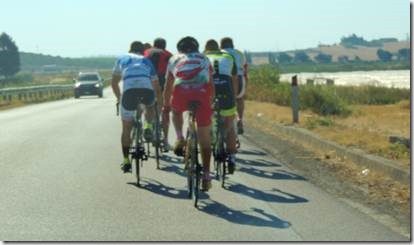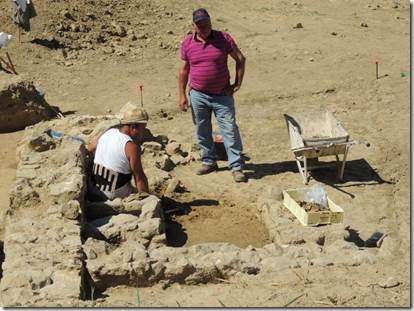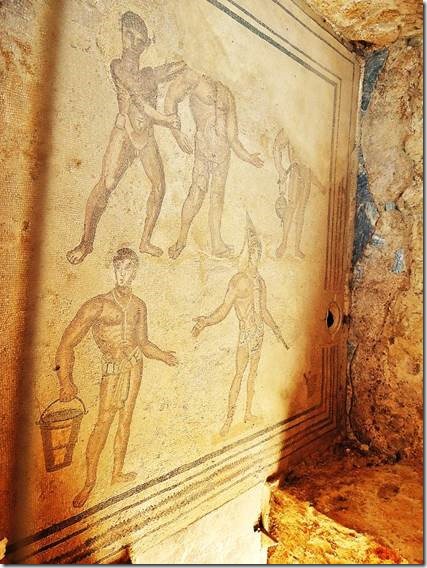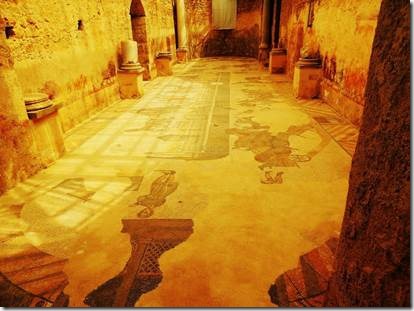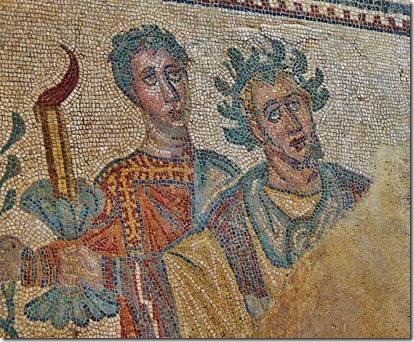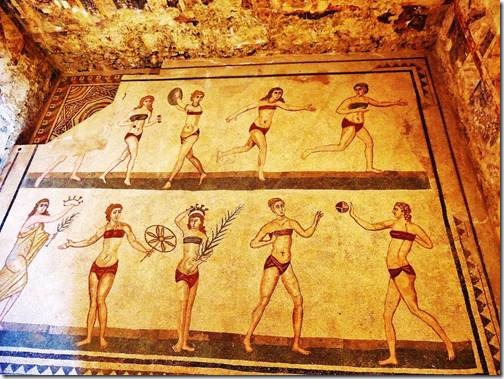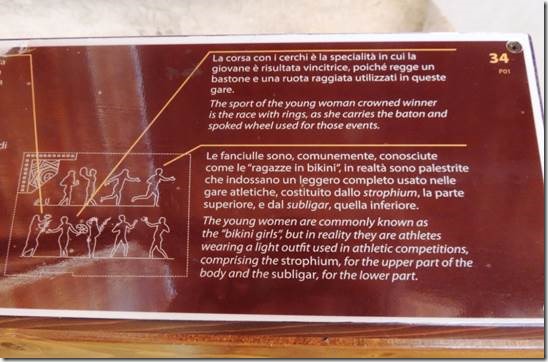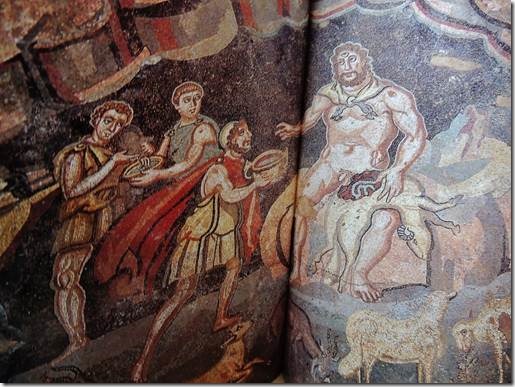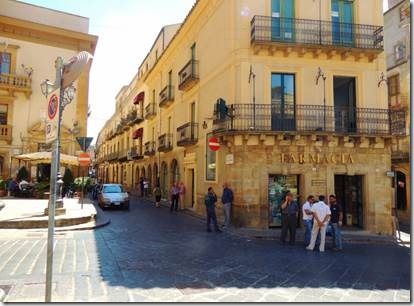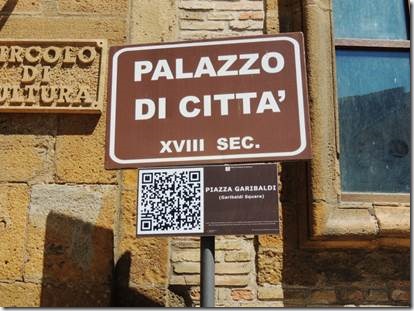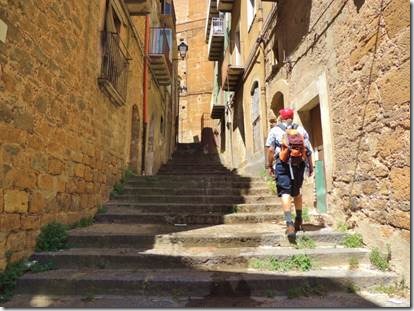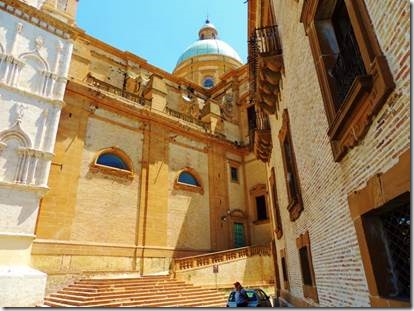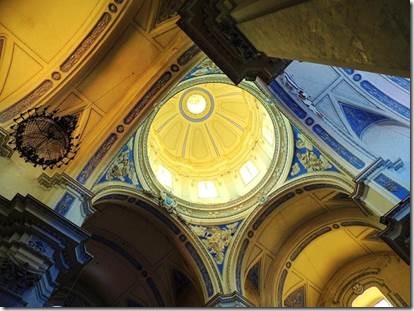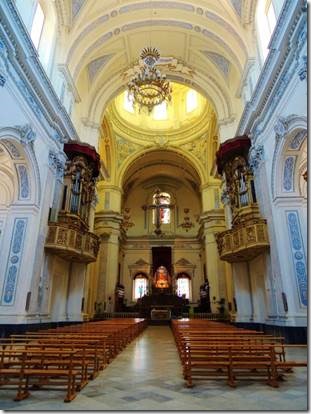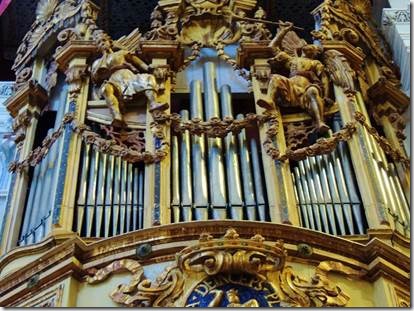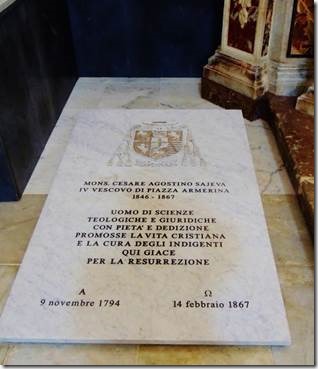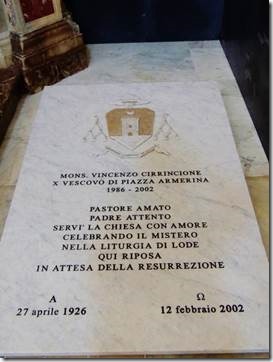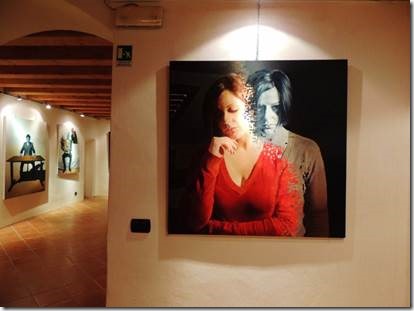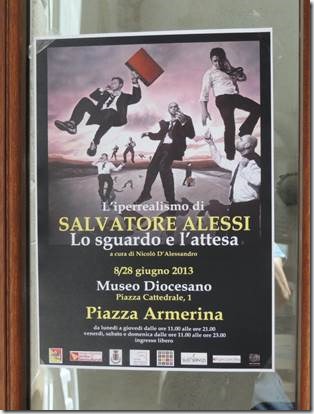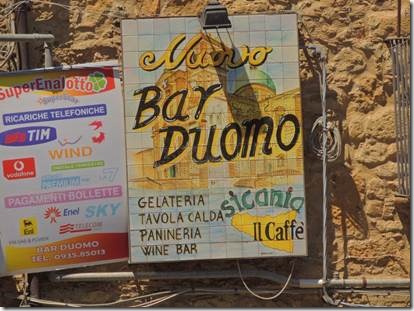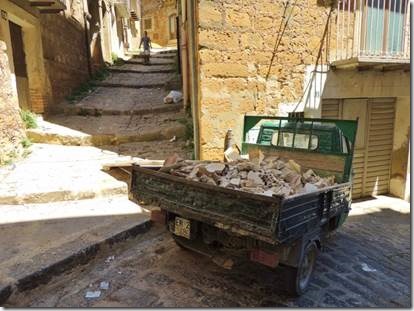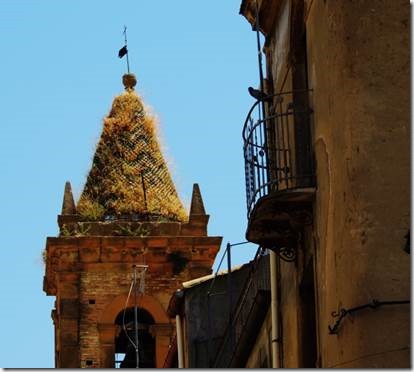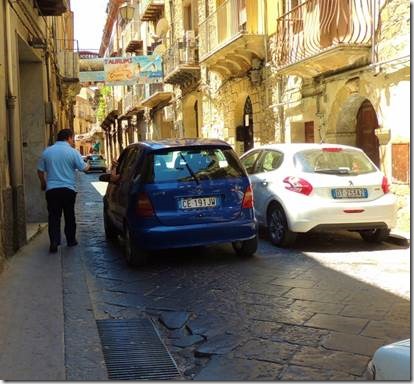Buona sera,
So, it looks as if we might get a weather break and be heading off for Tunisia on Monday. We do need to be on our way, but there’s really so much to see here in Sicily that one could spend much more time here. We spent just returned from several days in Palermo with our friends Linda and Frank and had a great time. What seems like a confusing mess from the autostrada made much more sense when you take the bus to the central terminal just near the old/central part of Palermo. Lots of fun; too much food!
This email returns to our car trip, the first and last mornings actually; Villa Romana del Casale and Piazza Armerina.
Ru
Piazza Armerina & Villa Romana del Casale
Villa Romana del Casale was the first stop of our Sicily road trip. The actual town of Piazza Armerina was our final stop the last day. We found driving to our destinations was fairly easy. But the closer you got, the more difficult as signs seemed to point in contradictory ways or disappear altogether. (Which reminds me of the joke: the food was terrible and there was so little of it.) Ultimately we found our way and most of the countryside and tiny towns with steep narrow streets were worth the occasional backtracking.
Randal has developed a fascination with Roman floor mosaics. His main reason for seeing Sicily was to visit Villa Romana del Casale famous for its extensive floor mosaics. We parked in the huge, mostly empty lot, as we’d gotten an early start that morning. Good thing as the lot was full when we left and the sun quite hot. We did stop for a snack at one of the stands near the entrance allowing several busloads of folks to arrive turning the place quite crowded. At the ticket booth are all of the “Do Not” signs including one with a camera indicating “no photos”. We were both really disappointed until we saw the entire tour group ahead of us clicking away as their guide watched. So we also ignored the sign but I have to say, none of our photos came out all that well. And it was hard to take in so much all at one time especially as it got even more crowed and quite hot. But we did “buy the souvenir book” so now can go back and read in leisure.
“Roman exploitation of the countryside is symbolized by the Villa Romana del Casale (in Sicily), the centre of the large estate upon which the rural economy of the Western Empire was based. The villa is one of the most luxurious of its kind. It is especially noteworthy for the richness and quality of the mosaics which decorate almost every room; they are the finest mosaics in situ anywhere in the Roman world.” http://whc.unesco.org/en/list/832
This link includes a video explaining the Unesco World Heritage site.
“These extraordinarily vivid mosaics, probably produced by North African artisans, deal with numerous subjects, ranging from Homeric escapades and mythological scenes to portrayals of daily life, including the famous tableau of girls exercising in their “bikinis”.
The Villa was built in four main sections: the main entrance with its thermal baths, a peristyle with living area and guest rooms, the private rooms of the owner, complete with basilica (public hall) and a triclinium (dining area) and elliptical courtyard.
Almost completely covered by a landslide in the 12th Century, the Villa was partly rediscovered in the 19th Century. However, not until the 20th Century, with the excavations of Paolo Orsi, Giuseppe Culrera and Gino Vinicio Gentile did the magnitude and magnificence of Villa Romana del Casale come to light. It is now a UNESCO Heritage site.” http://www.thinksicily.com/guide-to-sicily/towns-and-cities-in-sicily/piazza-armerina.aspx
http://sites.davidson.edu/csa/more-than-mosaics-villa-romana-del-casale-a-piazza-armerina-site-report-3/ is a really good description of the Villa Romana from the school’s Classics Abroad program
|
On the road to Piazza Armerina and the Villa Romana del Casale; bikers everywhere! Really serious kind of bikers all over Sicily, but also several bike tourists. |
|
Uncovering more remains at the Villa Romana del Casale just near the ticket booth and car park. |
|
Massage room floor (rotated to see the figures more easily) depicting a massage scene “At the center is the naked figure of the owner who has just emerged from the bath, being oiled and massaged. A slave is holding a strigil in his right hand (the curved instrument used to scrape off grease and sweat) and an ampule containing oil. In the foreground two slaves are wearing loincloths on which are written their names – Tite and Cassi. One is holding a situla, the other a boom and he is wearing a cone-shaped headdress used in Syria. The figures are mutilated due to the digging of a well in the Norman period and the restoration which dates back to VI century AD. The whole scene is bordered by cordons.” The Ancient Roman Villa of Casale at Piazza Armerina Past and Present |
|
Palaestra ; a room used by Romans for physical exercise. |
|
Vestibule, the room where the owner was greeted on his arrival home. “…at the top of the emblem are three figures, two are holding laurel branches, in the foreground, the other, dressed in a purple-bordered toga….with a beard, and wearing a crown of laurel, is holding a candelabrum with a burning candle with his right hand.” The Ancient Roman Villa of Casale at Piazza Armerina Past and Present |
|
Bikini Girls: one of the more famous mosaics from the Villa “This rectangular room with mosaic floor and frescoed walls was used by the servants…. As it was destined for servants’ use, the floor should have had a geometric design. In the southeast corner it can be seen that below the surface covered with figures, there is another with geometric patterns (the 3rd century original.) At a later date, in the 4th century, the purpose of the room changed and the new owners had the floor with the 10 girls in bikinis laid on top of the original.” The Ancient Roman Villa of Casale at Piazza Armerina Past and Present |
|
Many of the mosaics illustrated Greek mythology; this one from Homer’s Odyssey illustrated Ulysses and the Cyclopes. My photo was terrible so I used the one from the book. Ulysses offering wine to the Cyclopes mosaic photo from The Ancient Roman Villa of Casale at Piazza Armerina Past and Present
“The Cyclopes were giant beings with a single, round eye in the middle of their foreheads. According to Hesiod, they were strong, stubborn, and "abrupt of emotion." Their every action ebbed with violence and power. There are actually two generations of Cyclopes in Greek myth. The first generation consisted of three brothers, Brontes ("thunderer"), Steropes ("flasher"), and Arges ("brightener"), who came from the union of Gaia (earth) and Uranus (sky). The second generation descended from Poseidon, and the most famous of these was Polyphemus from Homer’s Odyssey. Brontes, Steropes, and Arges (the three descended from Gaia and Uranus) were the inventive blacksmiths of the Olympian gods. They were skilled metal workers and created Zeus’ thunderbolts, Poseidon’s trident, and Hades’ Helmet of Darkness that was later used by Perseus while on his quest to decapitate Medusa. However, they spent the majority of their early existence imprisoned. Their father Uranus (sky) hated all of his offspring (the Titans, Cyclopes, and Hecatonchires or hundred-handers) and kept them confined deep within Gaia (earth). The defeat of Uranus by his son Cronus (a Titan) freed the Cyclopes for a time, but Cronus was a paranoid ruler. He feared the Cyclopes’ power and cast them into Tartarus (the place of punishment in the underworld) where they remained imprisoned until Zeus (an Olympian and son of Cronus) released them, requiring their aid in the Titanomachy (battle of the Titans). With the assistance of the Cyclopes and their thunderbolts, Zeus overthrew Cronus and the Titans and became ruler of the cosmos. He was grateful for the Cyclopes’ help and allowed them to stay in Olympus as his armorers and helpers to Hephaestus, god of smiths. The Greeks also credited them with building the massive fortifications at Tiryns and Mycenae in the Peloponnese. Brontes, Steropes, and Arges are mainly mentioned in passing in most of the myths to convey strength in heroes and the fine quality of weapons but are major characters in one other event � their deaths at the hands of Apollo. Zeus struck Asclepius, Apollo’s son, down with a thunderbolt for having risen a person from the dead. Apollo was outraged and killed the Cyclopes who had forged the deadly thunderbolt. It appears that Apollo’s rage was misplaced, yet by killing the Cyclopes, he was indirectly punishing Zeus. The ghosts of Brontes, Steropes, and Arges are said to dwell in Mt. Aetna, an active volcano that smokes as a result of their burning forges. The second generation of Cyclopes was a band of lawless shepherds living in Sicily who had lost the skill of metallurgy. Polyphemus, son of Poseidon and the sea nymph Thoosa, is the only notable individual of the lot and figures prominently in Homer’s Odyssey. Odysseus and his crew landed on Sicily, realm of the Cyclopes. He and a few of his best men became trapped in Polyphemus’ cave when Polyphemus rolled a large boulder in front of the entrance to corral his sheep while Odysseus was still inside. Polyphemus was fond of human flesh and devoured many of the men for dinner. On the second night, Odysseus told Polyphemus that his name was "Nobody," and tricked him into drinking enough wine to pass out. While he was incapacitated, Odysseus/Nobody blinded him with a red hot poker. Polyphemus shouted in pain to the other Cyclopes on the island that "Nobody" was trying to kill him, so no one came to his rescue. Eventually, he had to roll away the stone to allow his sheep to graze. Odysseus and the remaining crew clung to the bellies of the exiting sheep where Polyphemus could not feel them as they passed him on their way to pasture and escaped. As Odysseus sailed away from the island, he shouted to Polyphemus that it was Odysseus who had blinded him. Enraged, the Cyclops threw huge boulders at the ship and shouted to his father, Poseidon, to avenge him. Recent scholars have hypothesized about the origin of the Cyclopes’ single eye. One possibility is that in ancient times, smiths could have worn an eye patch over one eye to prevent being blinded in both eyes from flying sparks. Also, smiths sometimes tattooed themselves with concentric circles which could have been in honor of the sun which provided the fire for their furnaces. Concentric rings were also part of the pattern for making bowls, helmets, masks, and other metal objects. Notice that the first generation Cyclopes were associated with metal-working while the second generation was not. Apparently, the lawless band of Cyclopes is a later addition to the myths. The incidence with Polyphemus seems to have had an independent existence from the Odyssey before Homer added it to his epic adventure. It was probably told as a separate myth at certain functions. It is uncertain why the Cyclopes were demoted from the smiths of the gods to a lawless group of monsters with no reverence for the gods. When the universe came into being, there were many monsters and vague forms that were gradually replaced with beings with more human forms. Order was replacing chaos. The monsters were phased out, and this could have lead to the transformation of the "good" Cyclopes to the "evil" Cyclopes that were destined to be fought and defeated by the divine human form. http://www.pantheon.org/articles/c/cyclopes.html |
|
The Villa Romana del Casale is located just near Piazza Armerina. We stopped at the villa our first morning and the town of Piazza Armerina our final morning. |
|
Those lovely narrow streets. |
|
My first thought was that it was a plaza from the 18th century. But I think it really is a city plaza according to section 18 of some code. But I liked the scanning code sign too. It’s also one of the zillion Garibaldi squares in Sicily. |
|
Walking to the Duomo up the old stone steps and narrow streets Duomo “The massive Baroque style Cathedral, which incorporates both Norman Gothic and Catalan Gothic features, was built over a long period of time. The upper part dates from the 16th century, the lower was built during the late 17th and early 18th centuries on the foundations of an existing church. The dome was completed in 1768” http://www.visitsitaly.com/sicily/piazza_armerina/ |
|
Looking up at the dome |
|
You can get “churched out” in Sicily as you can get “mosqued out” in Turkey. We haven’t been “synagogued” out yet as we’ve only been to about 4 in all of our travels; one in Rome, one in Tel Aviv, and two in Singapore. |
|
A close up of what looks like organ pipes. My friend Sharon’s son Asher refurbishes organs so this photo is particularly for them. |
|
I think these are head stones and these two men are buried here? |
|
The small café/art gallery/ next door. There were supposed to be church related items here, but we only found this contemporary art exhibit. |
|
Many Duomo have bars in the vicinity and most are called Bar Duomo or Duomo Bar |
|
Constant renovation is possible in countries with ancient history, earthquakes, volcanoes and war destruction. |
|
This bell tower was fascinating with grasses growing from it. |
|
The streets are narrow but no one seems to mind when folks in the car in front stop to chat holding up the traffic. |

